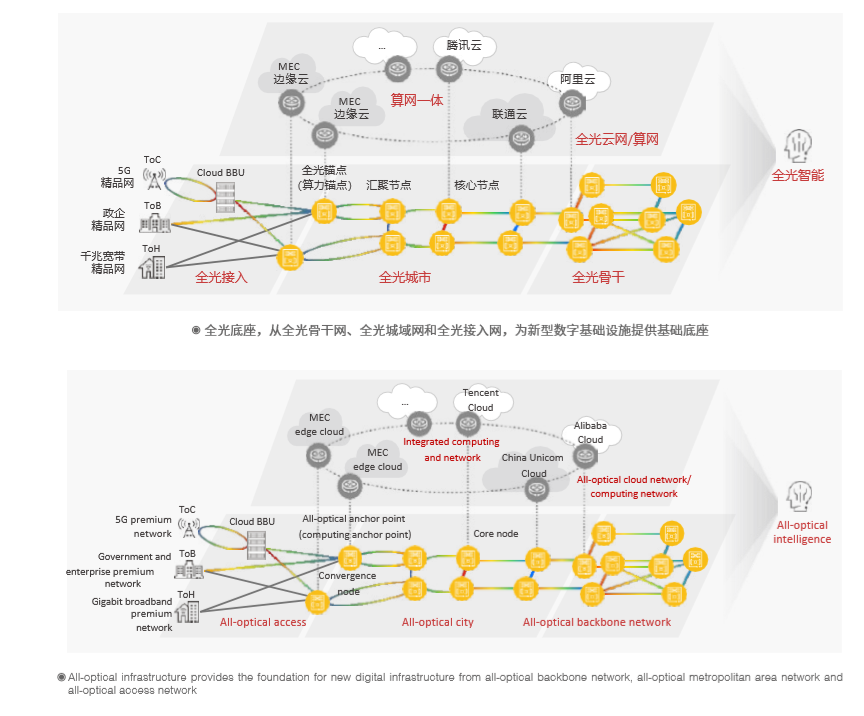
- Home
- Media Center
-
Events
- Wuzhen Summit
- Regional Forums
- Practice Cases of Jointly Building a Community with a Shared Future in Cyberspace
- World Internet Conference Awards for Pioneering Science and Technology
- The Light of Internet Expo
- Straight to Wuzhen Competition
- Global Youth Leadership Program
- WIC Distinguished Contribution Award
- Membership
- Research & Cooperation
- Digital Academy
-
Reports
- Collection of cases on Jointly Building a Community with a Shared Future in Cyberspace
- Collection of Shortlisted Achievements of World Internet Conference Awards for Pioneering Science and Technology
- Reports on Artificial Intelligence
- Reports on Cross—Border E—Commerce
- Reports on Data
- Outcomes of Think Tank Cooperation Program
- Series on Sovereignty in Cyberspace Theory and Practice
- Other Achievements
- About WIC
- 中文 | EN

Collection: All-optical infrastructure innovation and application of China Unicom
Introduction
China Unicom proposed the all-optical infrastructure system architecture, cooperated with Huawei to carry out all-optical infrastructure key technology, equipment development and networking application, and constructed a single-domain WSON intelligent all-optical backbone network covering China (186 ROADM+1279 OA). This network integrally realized multi-service comprehensive bearing of homes, enterprises, and computing power, which gains significant economic and social benefits and effectively improves the quality of network services for major international events such as the Beijing Winter Olympics.

Building the Largest Single-Domain WSON Network in the World
China Unicom's all-optical infrastructure system architecture starts from the challenges of network architecture, all-optical switching and all optical access, and realizes a number of technical innovations: The protection and coordination mechanism of OMSP and WSON, as well as the "centralized + distributed" control architecture are proposed for the first time. The 50 ms protection switching of the backbone ROADM network is realized, protection against 13 fiber cuts is implemented, and a single-domain WSON network covering the whole country is constructed. Then it is the first time to propose the metro pooling wavelength division technology in which access rings share aggregation nodes. This technology reduces space and power consumption by 50%, and implements automatic operation and maintenance based on digital labels, which makes the all-optical infrastructure solution the leading solution in the world. Next, the all-optical anchor for metro integrated service access was defined for the first time, and the all-optical access technology based on digital label pilot tone modulation and wavelength tuning was proposed, and the ITU-T G.698.4 standard was established with realizing integrated all-optical access for all-service operators. Besides, it also proposes the Optical Service Network (OSU) technology that supports service awareness, flexible service mapping, and bandwidth adjustment as well as its control protocol (OSP), and supports efficient access of any service from 2M to 100G.
All-optical Infrastructure has been Applied on a Large Scale and Gained Significant Economic and Social Benefits
China Unicom's all-optical infrastructure system architecture and network construction have achieved significant economic and social benefits. The direct economic benefits of this project are approximately CNY20 billion. Since this project was put into operation, it has served more than 213 million 5G users, more than 89 million broadband users, and more than 1 million government and enterprise private lines. The backbone ROADM network reduces power consumption by 1.28 billion watts per year, which is equivalent to reducing CO2 emissions by 746.73 tons and SO2 emissions by 38.56 tons. This project also benefited the Beijing 2022 Winter Olympics and Paralympics, creating a high-bandwidth, high-reliability, zero-packet-loss, and low-latency 8K UHD transport network to ensure that global audiences can enjoy 8K UHD Olympic feast. The all-optical infrastructure realizes "connected homes, connected enterprises, and joint computing", and has achieved significant social benefits in promoting the development of digital economy and digital transformation.
The Project Achievements Contribute to the Development and Evolution of the Global Internet, Fostering the Creation of a Global Cyberspace Community with a Shared Future
In the technology promotion and application innovation of next-generation optical networks, China Unicom and Huawei have carried out a large amount of research and testing work based on the all-optical infrastructure architecture and technical system, playing a leading role in the development and application of next-generation optical network technology. Driven by China's industry, more than 100 networks around the world have adopted the ROADM, pooling wavelength division, and all-optical access technologies, and more than 40 networks in 32 countries have adopted 400G technologies. The all-optical infrastructure has become the cornerstone of the development of the global Internet, helping countries achieve digitalization, networking, and intelligence in the information age.

The World Internet Conference (WIC) was established as an international organization on July 12, 2022, headquartered in Beijing, China. It was jointly initiated by Global System for Mobile Communication Association (GSMA), National Computer Network Emergency Response Technical Team/Coordination Center of China (CNCERT), China Internet Network Information Center (CNNIC), Alibaba Group, Tencent, and Zhijiang Lab.





